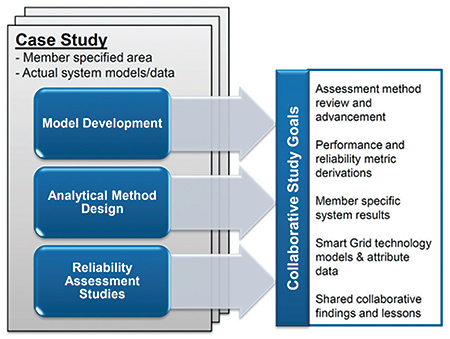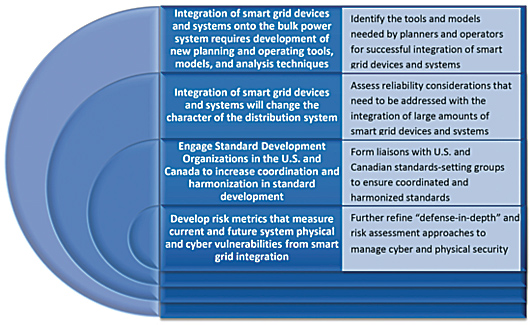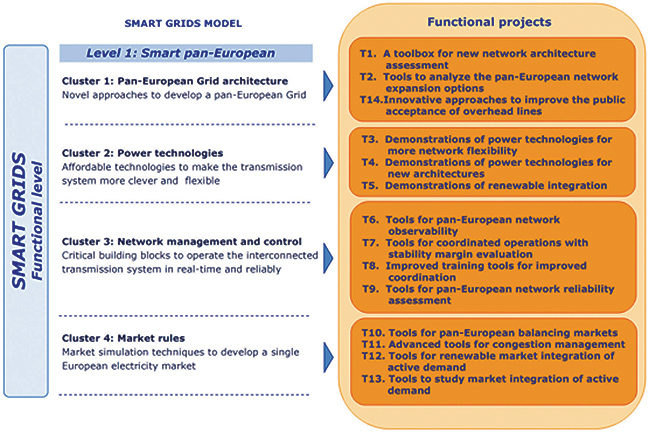Part I (Electric Energy T&D January/February 2013) looked at R&D challenges, exploratory workshop purpose, reliability assessment concerns and gaps, and reliability and performance indices. Pinpointed subjects included:
- Model and Data Limitations
- Variable and Intermittent Resource Integration
- Protection Coordination
- Distributed Energy Resource Integration
- Information Technology Dependence
- Control System Architecture Interaction and Design
- Education and Training
Future Research Framework
The ultimate goal of this effort is the development of metrics, models, and methods required to assess reliability and plan the future smart grid. A significant takeaway from the workshops, however, is the array of potential reliability assessment areas requiring further R&D.
An initial phase will provide a complete evaluation of current reliability assessment practices of smart grid technologies to qualitatively determine the criticality of potential reliability impacts, identifying the current state-of-the-art. This will be achieved by reviewing the existing body of work in this area and through periodic forums to facilitate the sharing of industry experiences and solutions.
In parallel, characteristics of key smart grid technologies will be clarified and examined along with potential data needs required to effectively model the devices and systems. These findings will be compiled to qualitatively determine the criticality of particular reliability assessment areas.
The second phase will focus on critical gaps through case studies designed to demonstrate new reliability assessment functions. A collaborative case study-driven framework is proposed, which will develop a collection of directed studies and analyses targeting various smart grid applications. As illustrated in Figure 1, the case study framework will not only provide system-specific findings, but more importantly will serve as the catalyst for developing the models, methods, and metrics needed in the industry.

Figure 1: Collaborative Case Study-Driven Research and Development Framework
Using actual system models and data in these case studies, the developed tools will be designed and tested in real-world applications. Finally, the collaborative research framework will enhance the existing body of knowledge on reliability assessment and smart grid characteristics through the sharing of findings and derived tools.
Example Case Study and Assessment Areas
The table below outlines potential case study areas. Many of these research areas are interrelated and will provide insights into the targeted issue as well as related assessment areas. The findings can be further leveraged as part of the larger collaborative effort through the aggregation and review of multiple case study results. In addition, cross-cutting case studies can examine potential interactions and interference by combining different technologies and applications.
|
Reliability Issue |
Study Area |
Assessment Gaps |
|
DER Ancillary Service Participation |
Identify constraints on demand response and other DER’s ability to provide ancillary services |
|
|
Characterizing System Flexibility |
System flexibility assessment and potential utilization of DER to accommodate variable generation |
|
|
Protection Coordination |
Impact to UFLS and UVLS schemes from distribution smart grid applications |
|
|
Increased System Complexity |
Communication and control failure impacts to bulk system security and adequacy |
|
|
Monitoring, Control, and Visibility |
Evaluate reliability benefits of distribution level visibility and potentially adverse automated control system interactions |
|
|
System Frequency Response |
Calculate the system stability and frequency impacts from changing system inertia and high penetration of DER |
|
|
Reactive Power Support |
Assessment of volt/var interactions and voltage stability issues from high penetration of DER |
|
|
Incorporating Customer Behavior |
Evaluate impacts from increasing reliance upon dispatched and non-dispatched demand response |
|
|
Dealing with Contingencies |
Assessment of system impacts of wide-spread disconnects of DER due to bulk system events |
|
| ACRONYMS DER – distributed energy resources UFLS – under-frequency load shedding |
UVLS – under-voltage load shedding DMS – distribution management systems EV – electric vehicle |
APPENDIX
NERC Smart Grid Task Force
The North American Electric Reliability Corporation (NERC) mission is to ensure the reliability of the North American bulk power system. NERC develops and enforces reliability standards; assesses adequacy annually via a 10-year forecast, and summer and winter forecasts; monitors the bulk power system; and educates, trains, and certifies industry personnel.
The Smart Grid Task Force (SGTF) was set up by NERC to identify and explain any issues and/or concerns of the smart grid with respect to bulk power system reliability and to assess smart grid reliability characteristics and how they may affect bulk power system planning, design, and operational processes and the tools that may be needed to maintain reliability. This task force is part of the Critical Infrastructure Strategic Roadmap and the Coordinated Action Plan. The SGTF released a report stating successful integration of smart grid devices can improve reliability but also recognized smart grid integration may result in substantial changes to the bulk power system.1 In response, the task force developed a work plan (Figure 2), identifying issues and next steps towards successful integration of smart grid devices and systems. Issues included the development of new planning tools as well as the need to account for changing distribution system characteristics.

Figure 2: NERC Smart Grid Task Force Recommended Work Plan2
ENTSO-E
The European Network of Transmission System Operators for Electricity (ENTSO-E) speaks for all electric transmission system operators (TSOs) in the EU and others connected to their networks, with one voice for all regions, and for all of their technical and market issues. The European TSOs agree and have founded ENTSO-E intending to play an active and important role in the European rule setting process and to push network codes and pan- European network planning forward urgently.
ENTSO-E and the EDSO-SG (European Distribution System Operators for Smart Grids) released the European Electricity Grid Initiative (EEGI), which is one of the European Industrial Initiatives under the Strategic Energy Technology Plan (SET-Plan).2 The EEGI proposes a 9-year European research, development, and demonstration (RD&D) program to accelerate innovation and the development of the electricity networks of the future in Europe. This program outlines a set of Functional Projects organized by clusters and Smart Grid function levels from the New Generation Technologies (Level 0) to the Smart Customers (Level 5). Transmission network activities organized according to four clusters corresponding to the four basic activities of a network operator (planning, investments, operations, and power markets) are shown in Figure 3. Transmission and distribution networks will increasingly need to coordinate their operations and exchange data in real time. Functional RD&D activities including increased visibility of electric network for system management and control, the integration of demand side management in TSO operations, and ancillary services provided by DSOs were also proposed.

Figure 3: EEGI Transmission Level Activities3
(click to enlarge)
EPRI Grid Transformation
In general, ‘Smart Grid’ refers to a modernization of the electricity delivery system so that it monitors, protects, and automatically optimizes the operation of its interconnected elements – from the central and distributed generator through the high-voltage transmission network and distribution system, to industrial users and building automation systems, to energy storage installations, and to consumers and their thermostats, electric vehicles, appliances, and other household devices.3
In 2011, EPRI identified three technology pillars to facilitate the transformation ta a smarter transmission system: Grid Development and Operation, Asset Life-Cycle Management, and Information and Communication Technologies.3 A fundamental component in realizing the Grid Development and Operations pillar is to craft reliability assessment tools to address future challenges in this new era of power transmission. These tools will be necessary for planners and operators to successfully integrate an evolving array of new technologies, renewable generation, and demand-side resources. In addition, these tools are fundamental in formulating long term regional, inter-regional, and interconnection wide transmission plans.

Figure 4: Technology Pillars for a Smarter Transmission Grid3
A significant portion of smart grid activities in the industry have been focused at the distribution and customer levels given the significant opportunities increased visibility and controllability can provide at these levels. Accordingly, a vast array of smart grid devices and applications have been proposed and demonstrated. These activities have already initiated advancements in distribution system analysis tools to support distributed resource integration and grid modernization; for example, EPRI’s electric power Distribution System Simulator (OpenDSS). Advancements in bulk system assessment tools to address the changing distribution system characteristics due to smart grid applications continue to be relatively minimal. This is especially troublesome considering many long-term visions for integrating large amounts of distributed resources with bulk system operations. Nonetheless, new distribution analysis tools represent an important resource towards understanding and portraying potential distribution characteristics at the bulk system level.
References
1 Reliability Considerations from the Integration of the Smart Grid, NERC. Atlanta, GA: December 2010
2 The European Electricity Grid Initiative (EEGI) Roadmap and Implementation Plan: EEGI, May 2010
3 A Smarter Transmission Grid, EPRI, Palo Alto, CA January 2011.1022305
EPRI would like to acknowledge and thank all attendees at both the European and North American workshops for their active engagement and valuable input.
About the author
 Jason Taylor is a Senior Project Engineer in the Power System Studies Group at EPRI. Dr. Taylor has worked in the industry for over a decade and holds a doctorate from Auburn University. His current research targets the advancement of reliability assessment metrics, models, and methods needed to evaluate and design a ‘smarter’ power system. He is a member of the NERC Smart Grid Task Force and a chair of the CIGRE committee on Planning and Optimization Methods for Active Distribution Systems. Dr. Taylor can be reached at jtaylor@epri.com
Jason Taylor is a Senior Project Engineer in the Power System Studies Group at EPRI. Dr. Taylor has worked in the industry for over a decade and holds a doctorate from Auburn University. His current research targets the advancement of reliability assessment metrics, models, and methods needed to evaluate and design a ‘smarter’ power system. He is a member of the NERC Smart Grid Task Force and a chair of the CIGRE committee on Planning and Optimization Methods for Active Distribution Systems. Dr. Taylor can be reached at jtaylor@epri.com








